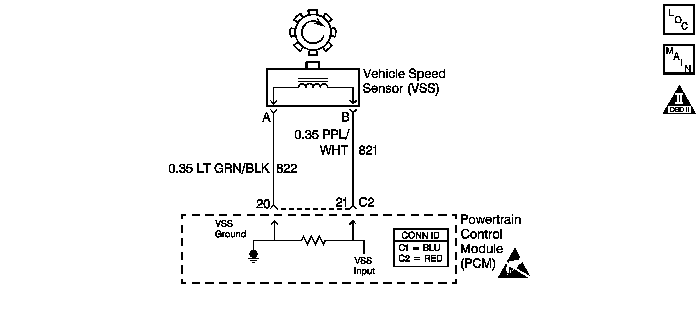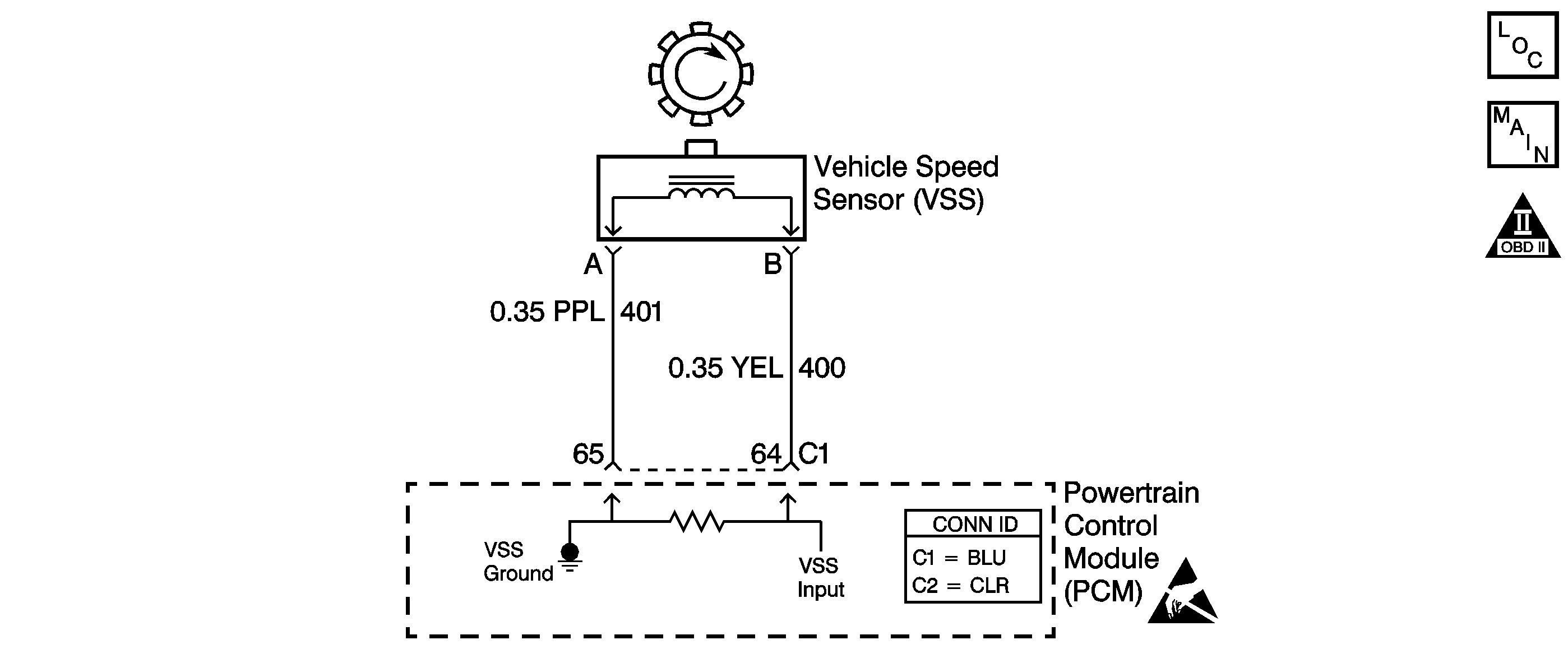DTC P0502 Vehicle Speed Sensor (VSS) Circuit Low Input 5.7L

Circuit Description
The vehicle speed sensor (VSS) assembly provides vehicle speed information to the powertrain control module (PCM). The VSS assembly is a permanent magnet (PM) generator. The PM generator produces a pulsing AC voltage as rotor teeth on the transmission output shaft pass through the sensor's magnetic field. The AC voltage level and the number of pulses increase as the speed of the vehicle increases. The PCM converts the pulsing voltage to vehicle speed. The PCM uses the vehicle speed signal to determine shift timing and torque converter clutch (TCC) scheduling.
If the PCM detects a low vehicle speed when there is a high engine speed in a drive gear range, then DTC P0502 sets. DTC P0502 is a type B DTC.
Conditions for Running the DTC
| • | No MAF sensor DTCs P0101, P0102 or P0103. |
| • | No MAP sensor DTCs P0107 or P0108. |
| • | No TP sensor DTCs P0122 or P0123. |
| • | No TFP manual valve position switch DTC P1810. |
| • | The engine vacuum is 0-105 kPa. |
| • | The engine torque is 30-400 lb ft. |
| • | The TP angle is greater than 15%. |
| • | The engine speed is greater than 3000 RPM. |
| • | The transmission is not in PARK or NEUTRAL. |
Conditions for Setting the DTC
The transmission output speed is less than 150 RPM for 2.5 seconds.
Action Taken When the DTC Sets
| • | The PCM illuminates the malfunction indicator lamp (MIL) during the second consecutive trip in which the Conditions for Setting the DTC are met. |
| • | The PCM commands second gear only. |
| • | The PCM commands maximum line pressure. |
| • | The PCM inhibits TCC engagement. |
| • | The PCM freezes shift adapts from being updated. |
| • | The PCM records the operating conditions when the Conditions for Setting the DTC are met. The PCM stores this information as Freeze Frame and Failure Records. |
| • | The PCM stores DTC P0502 in PCM history during the second consecutive trip in which the Conditions for Setting the DTC are met. |
Conditions for Clearing the MIL/DTC
| • | The PCM turns OFF the MIL during the third consecutive trip in which the diagnostic test runs and passes. |
| • | A scan tool can clear the MIL/DTC. |
| • | The PCM clears the DTC from PCM history if the vehicle completes 40 warm-up cycles without an emission-related diagnostic fault occurring. |
| • | The PCM cancels the DTC default actions when the fault no longer exists and/or the ignition switch is OFF long enough in order to power down the PCM. |
Diagnostic Aids
| • | Inspect the connectors at the PCM, the VSS assembly and all other circuit connecting points for an intermittent condition. Refer to Testing for Intermittent Conditions and Poor Connections in Wiring Systems. |
| • | Inspect the circuit wiring for an intermittent condition. Refer to Testing for Electrical Intermittents in Wiring Systems. |
Test Description
The numbers below refer to the step numbers on the diagnostic table.
-
Disable the traction control system when performing this step. When the ignition key is cycled to the OFF position and then cycled back ON, the traction control system defaults to ON.
-
This step tests the VSS assembly circuit.
-
This step tests the integrity of the VSS assembly.
Step | Action | Value(s) | Yes | No |
|---|---|---|---|---|
1 | Did you perform the Powertrain Diagnostic System Check? | -- | Go to Powertrain On Board Diagnostic (OBD) System Check in Engine Controls | |
Important: Before clearing the DTC, use the Scan Tool in order to record the Freeze Frame and Failure Records. Using the Clear Info function erases the Freeze Frame and Failure Records from the PCM. With the drive wheels rotating, does the Scan Tool Transmission OSS increase with the drive wheel speed? | -- | Go to Diagnostic Aids | ||
Does the resistance measure within the specified range? | 1377-3355 ohms | |||
Does the voltage measure greater than the specified value? | 0.5 volts | |||
5 | Measure the resistance from terminal C2-21 to ground. Does the resistance measure greater than the specified value? | 50 K ohms | ||
6 |
Refer to Circuit Testing and Wiring Repairs in Wiring Systems. Did you find and correct the condition? | -- | ||
7 |
Does the resistance measure within the specified range? | 1377-3355 ohms | ||
8 | Was the resistance measured in Step 3 greater than the specified value? | 3355 ohms | ||
9 |
Refer to Circuit Testing and Wiring Repairs in Wiring Systems. Did you find and correct the condition? | -- | -- | |
10 |
Refer to Circuit Testing and Wiring Repairs in Wiring Systems. Did you find and correct the condition? | -- | -- | |
11 | Test the input circuit (CKT 821) and the ground circuit (CKT 822) of the VSS assembly for a short together. Refer to Circuit Testing and Wiring Repairs in Wiring Systems. Did you find and correct the condition? | -- | -- | |
12 |
Did you find and correct the condition? | -- | ||
13 | Replace the VSS assembly. Refer to Vehicle Speed Sensor Replacement . Did you complete the replacement? | -- | -- | |
14 | Replace the PCM. Refer to Powertrain Control Module Replacement/Programming in Engine Controls. Did you complete the replacement? | -- | -- | |
15 | Perform the following procedure in order to verify the repair:
Has the test run and passed? | -- | System OK |
DTC P0502 Vehicle Speed Sensor (VSS) Circuit Low Input 3.8L

Circuit Description
The vehicle speed sensor (VSS) assembly provides vehicle speed information to the powertrain control module (PCM). The VSS assembly is a permanent magnet (PM) generator. The PM generator produces a pulsing AC voltage as rotor teeth on the transmission output shaft pass through the sensor's magnetic field. The AC voltage level and the number of pulses increase as the speed of the vehicle increases. The PCM converts the pulsing voltage to vehicle speed. The PCM uses the vehicle speed signal to determine shift timing and torque converter clutch (TCC) scheduling.
If the PCM detects a low vehicle speed when there is a high engine speed in a drive gear range, then DTC P0502 sets. DTC P0502 is a type B DTC.
Conditions for Running the DTC
| • | No MAP sensor DTCs P0107 or P0108 |
| • | No TP sensor DTCs P0122 or P0123 |
| • | No TFP manual valve position switch DTC P1810 |
| • | The transmission is not in PARK or NEUTRAL |
| • | The TP angle is greater than 12%. |
| • | The engine vacuum is 0-105 kPa. |
| • | The engine speed is greater than 3000 RPM. |
| • | The engine torque is 40-400 lb ft. |
Conditions for Setting the DTC
The transmission output speed is less than 150 RPM for 2.5 seconds.
Action Taken When the DTC Sets
| • | The PCM illuminates the malfunction indicator lamp (MIL) during the second consecutive trip in which the Conditions for Setting the DTC are met. |
| • | The PCM commands second gear only. |
| • | The PCM commands maximum line pressure. |
| • | The PCM inhibits TCC engagement. |
| • | The PCM freezes shift adapts from being updated. |
| • | The PCM records the operating conditions when the Conditions for Setting the DTC are met. The PCM stores this information as Freeze Frame and Failure Records. |
| • | The PCM stores DTC P0502 in PCM history during the second consecutive trip in which the Conditions for Setting the DTC are met. |
Conditions for Clearing the MIL/DTC
| • | The PCM turns OFF the MIL during the third consecutive trip in which the diagnostic test runs and passes. |
| • | A scan tool can clear the MIL/DTC. |
| • | The PCM clears the DTC from PCM history if the vehicle completes 40 warm-up cycles without an emission-related diagnostic fault occurring. |
| • | The PCM cancels the DTC default actions when the fault no longer exists and/or the ignition switch is OFF long enough in order to power down the PCM. |
Diagnostic Aids
| • | Inspect the connectors at the PCM, the VSS assembly and all other circuit connecting points for an intermittent condition. Refer to Testing for Intermittent Conditions and Poor Connections in Wiring Systems. |
| • | Inspect the circuit wiring for an intermittent condition. Refer to Testing for Electrical Intermittents in Wiring Systems. |
Test Description
The numbers below refer to the step numbers on the diagnostic table.
Step | Action | Value(s) | Yes | No |
|---|---|---|---|---|
1 | Did you perform the Powertrain Diagnostic System Check? | -- | Go to Powertrain On Board Diagnostic (OBD) System Check in Engine Controls | |
2 |
Important: Before clearing the DTC, use the Scan Tool in order to record the Freeze Frame and Failure Records. Using the Clear Info function erases the Freeze Frame and Failure Records from the PCM. With the drive wheels rotating, does the Scan Tool Transmission OSS increase with the drive wheel speed? | -- | Go to Diagnostic Aids | |
Does the resistance measure within the specified range? | 1377-3355 ohms | |||
Does the voltage measure greater than the specified value? | 0.5 volts | |||
5 | Measure the resistance from terminal C1-64 to ground. Does the resistance measure greater the specified value? | 50 K ohms | ||
6 |
Refer to Circuit Testing and Wiring Repairs in Wiring Systems. Did you find and correct the condition? | -- | ||
7 |
Does the resistance measure within the specified range? | 1377-3355 ohms | ||
8 | Was the resistance measured in Step 3 greater than the specified value? | 3355 ohms | ||
9 |
Refer to Circuit Testing and Wiring Repairs in Wiring Systems. Did you find and correct the condition? | -- | -- | |
10 |
Refer to Circuit Testing and Wiring Repairs in Wiring Systems. Did you find and correct the condition? | -- | -- | |
11 | Test the input circuit (CKT 400) and the ground circuit (CKT 401) of the VSS assembly for a short together. Refer to Circuit Testing and Wiring Repairs in Wiring Systems. Did you find and correct the condition? | -- | -- | |
12 |
Did you find and correct the condition? | -- | ||
13 | Replace the VSS assembly. Refer to Vehicle Speed Sensor Replacement . Did you complete the replacement? | -- | -- | |
14 | Replace the PCM. Refer to Powertrain Control Module Replacement/Programming in Engine Controls. Did you complete the replacement? | -- | -- | |
15 | Perform the following procedure in order to verify the repair:
Has the test run and passed? | -- | System OK |
